
Prevent Cross-Site Tracking on Samsung Galaxy F34 5G and Browser | Dr.fone

Prevent Cross-Site Tracking on Samsung Galaxy F34 5G and Browser
Have you ever wondered why you get the advertisements of the websites you visited a few minutes ago on your social media sites? Here comes to Cross-Site Tracking, also termed CST, and it is a process where third-party cookies and sites track your browser history.
 Power Tools add-on for Google Sheets, Lifetime subscription
Power Tools add-on for Google Sheets, Lifetime subscription
![]()
The CST process is like invading your privacy by collecting your browser history and personal information. So, to prevent these services, there are several ways by which you can cross-site tracking on your system as well as Samsung Galaxy F34 5G phone browsers. Keep reading to learn how to stop cross-site tracking on both Samsung Galaxy F34 5G and browser.
Part 1: Why Do We Need to Stop Cross-site Tracking?
Cross-site Tracking is all about collecting your browsing data and other information for advertising purposes. Though the process can prove convenient for many as it provides additional information about the products and services you have searched for and offers tailor-made content, it is intrusive and about breaching your privacy.
Cross-site tracking collects information about your browsing history. The third-party cookies also monitor the content type you have visited and your personal information, which is risky.
Besides invading privacy, the CST also poses several other issues. Based on your browsing history, additional content you have not asked for is loaded on your visited sites, slows down the page loading process, and puts an extra burden on your battery. Moreover, too much-unwanted content can interfere with the basic information you are looking for.
So, it is always better to prevent cross-site tracking for all the above and more reasons.
Further reading: A detailed guide on faking location in Mozilla Firefox . Don’t worry about your location privacy anymore!
Part 2: Can Private Browsing be traced?
Yes, private browsing can be traced. When you work in private browsing mode, the web browser does not save the browsing history, which means that anyone who uses your system will not check your online activities. But websites and cookies can track your browsing history as well as other information.
Part 3: How to Disable Cross-website Tracking on Safari for iOS Devices?
Safari is the most commonly used platform by iOS users. So, to prevent CST for Safari on your iOS devices and Mac systems, below is a complete guide.
Deactivate Safari cross-website tracking for iPhone & iPad
Safari cross-site tracking can be prevented using the below steps on your iPhone and iPad.
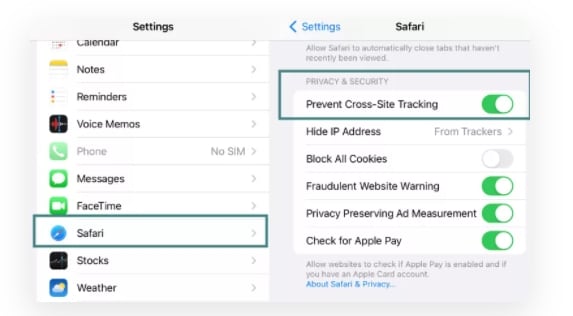
- Step 1. Launch the Settings app on your iOS device.
- Step 2. Find the Safari option by scrolling down the menu.
- Step 3. Move the slider to turn on “Prevent Cross-Site Tracking” under the PRIVACY & SECURITY option.
Deactivate Safari cross-website tracking for Mac
Use the steps below to turn off cross-site tracking on Safari on your Mac systems.
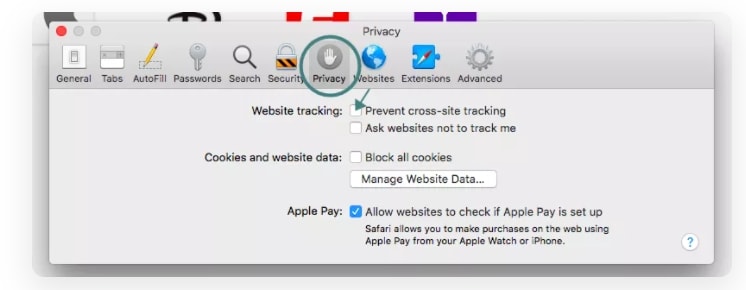
- Step 1. On your Mac system, open the Safari app.
- Step 2. Move to Safari > Preferences > Privacy
- Step 3. Enable the “Prevent cross tracking” option by clicking on the box next to it.
Part 4: How to Disable Cross-site Tracking on Google Chrome
Chrome is used widely on Windows systems and Android devices, and to prevent the CST from your browser, a detailed guide is given below.
Enable “Do Not Track” on Google Chrome for Android
- Step 1. On your Samsung Galaxy F34 5G, open the Chrome app.
- Step 2. At the right side of the address bar, click on the More option and choose Settings.
- Step 3. Choose the Privacy option from the Advanced tab.
- Step 4. Click on the “Do Not Track” option to turn on the feature.

Enable “Do Not Track” on Google Chrome for Computer
- Step 1. Launch Chrome on your system, and from the menu at the upper-right corner, click on the Settings option.
- Step 2. From the “Privacy and Security” tab, choose the “Cookies and other site data” option.
- Step 3. Tap and enable the slider next to “Send a “Do not track” request with your browsing traffic.”

Part 5: Recommended Solution: Fake a Location to Stop Cross-Site Location Tracking Using Dr. Fone
What if you let the sites and cookies track your phone location without worrying about your privacy? Yes, it can be done by spoofing your location. So, if you set a fake location while browsing the internet, you will not have to worry about cross-site tracking, as anyways, the sites and cookies will get misled browsing information that cannot harm you in any manner.
Setting a fake location on your iOS devices, a professional tool is needed, for we recommend Wondershare Dr.Fone - Virtual Location as the best tool. Using this Android and iOS-based software, you can set any fake GPS location on your device. The tool is simple to use and does not require any mastery of technical know-how.
Key features
- Simple tool to teleport to any GPS location in a single click.
- Allows simulating GPS movement along the route.
- All popular models of Android and iOS devices are compatible.
- Compatible with all location-based apps on your phone.
- Compatible with Windows and Mac systems.
Here is a video tutorial for you to take an overview of how to use Dr.Fone - Virtual Location to fake location on your Android and iOS devices.

Steps to set fake location on your Android and iOS devices using DrFone-Virtual Location
Step 1. Download, install and launch the software on your Windows or Mac systems. On the main software interface, choose the Virtual Location option.

Step 2. Connect your iPhone or Android device to your system using a USB cable and then tap on the Get Started option on your software interface.
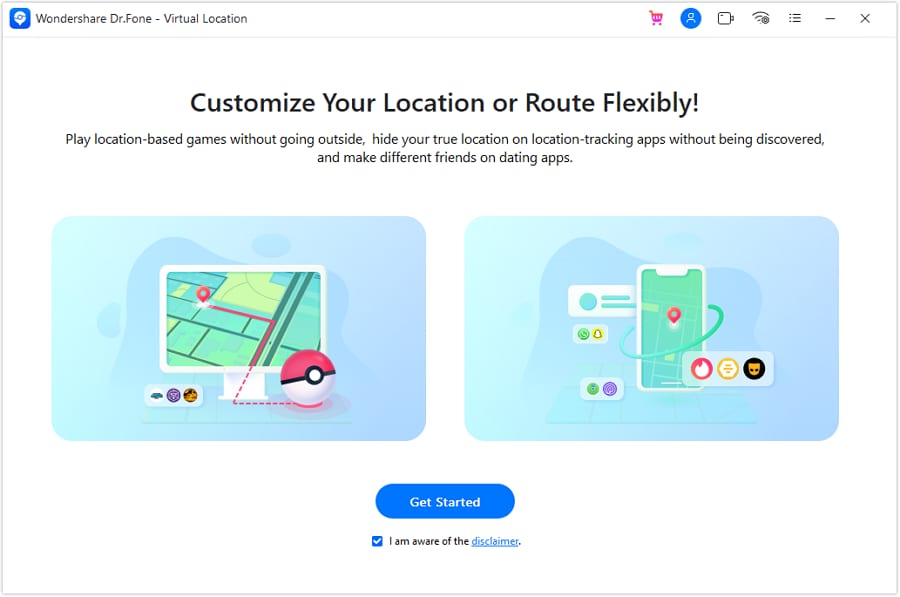
Step 3. A new window on the software interface will open, showing your connected phone’s real and actual location. If the detected location is incorrect, click on the “Center On” icon to display the right device location.
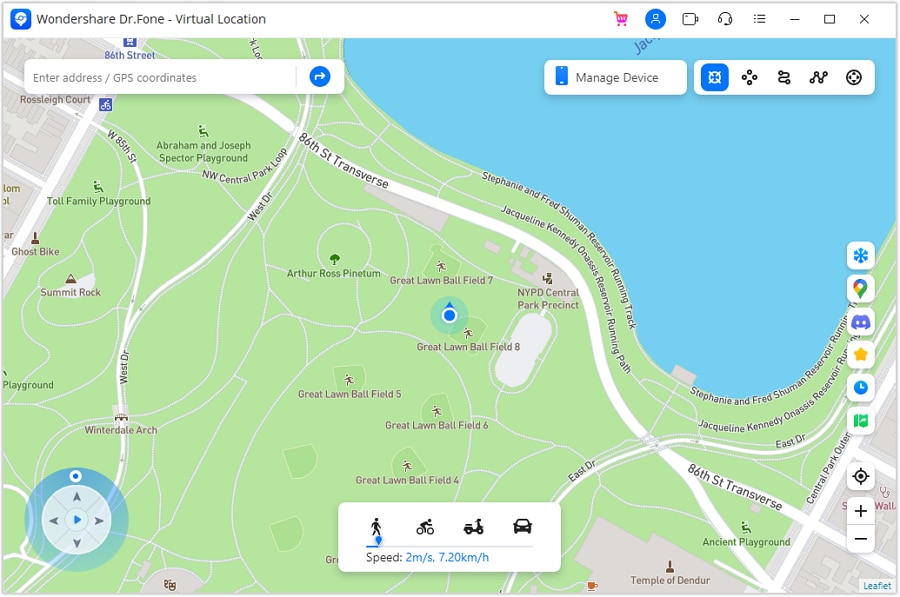
Step 4. Next, you need to activate the “teleport mode” and click o the 3rd icon at the upper-right corner.
Step 5. Next, you have to enter now the fake location to which you wish to teleport to at the upper-left corner. Click on Go.

Step 6. Finally, tap on the Move Here button and the new fake location for your connected Android or iOS device at the pop-up box.
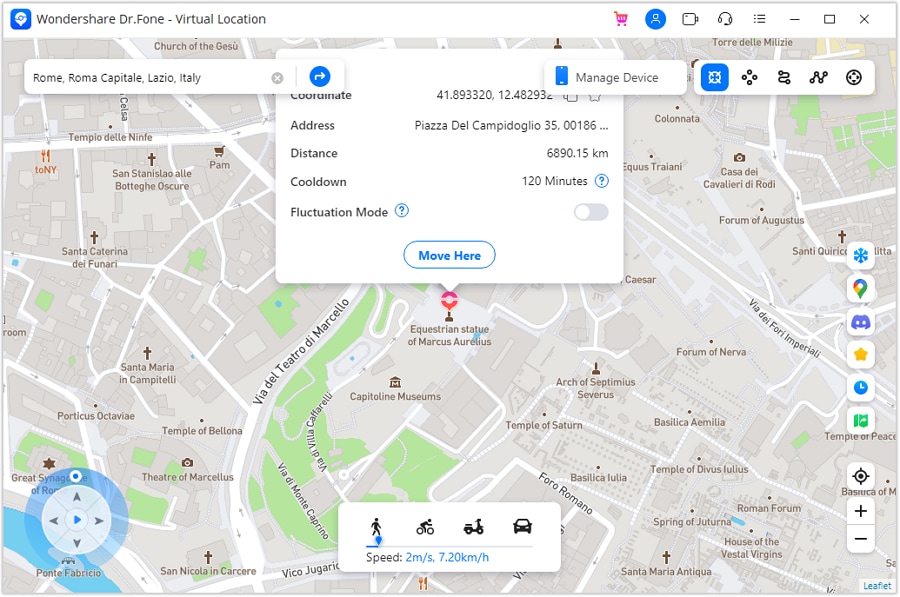
Check the new location of your phone from the app.

Wrap it up
Preventing Cross-site tracking can be done on different browsers and devices using the guides listed in the above parts of the article. Settings a fake location for your device using Dr. Fone-Virtual Location is another interesting way to prevent tracking your browsing history by spoofing the sites and cookies. Setting a fake place will not only avoid monitoring your browsing history but will also work with all location-based apps on your phone.
safe & secureThe Best 8 VPN Hardware Devices Reviewed On Samsung Galaxy F34 5G
In today’s world, it is highly recommended to use a VPN while using the internet. Although it helps us access geo-restricted content, it can also strengthen our security. Besides using a VPN software, you can also use a VPN hardware as well. For instance, a hardware VPN for home use can be connected to your network and let all the Samsung Galaxy F34 5G devices enjoy its benefit. To help you pick an ideal hardware VPN, we have come up with this guide. In this post, we have compared various Amazon hardware VPN options and have handpicked the top 8 of them for you.
If you want to use a hardware VPN for your home or business needs, then you can certainly meet your requirements with these options.
1. Cisco Systems Gigabit Dual WAN VPN
If you have already used Cisco products in the past, then you won’t face any trouble using this Amazon hardware VPN as well. It provides a wired connection with its 14 different LAN ports.
- Load balancing is supported by its dual gigabit Ethernet WAN ports
- Has an inbuilt SSL (Secure Socket Layer) and SPI (Stateful Packet Inspection) firewall.
- It is quite easy to perform its setup, as it comes with an intuitive GUI setup wizard.
- You can analyze employee productivity as it can manage different users at once.
- It is an advanced IP Security VPN hardware.
- The data transfer rate is 100 Mbps
- Warranty: 90 days
Price: $172

2. Zyxel Next Generation VPN Firewall
This VPN hardware by Zyxel will help you meet your business needs for sure. It is one of the most secure devices that you can try to get an access to around 100 VPNs.
- The hardware VPN supports up to 60 thousand sessions at the same time
- Provides an SHA-3 encryption
- It supports a speed of 300 Mbps VPN and 1 Gbps firewall
- Provides a dual-WAN fallback and failover support
- Besides IPSec, it includes SSL tunnels as well (IPv6 is also supported)
- Layer 2 Tunneling Protocol for mobiles (Android, iOS, and Windows phones)
- Warranty: 2 years
Price: $450 (for 100 VPNs), $950 (for 300 VPNs), and $1350 (for 1000 VPNs)

3. GL.iNet GL-AR150 Mini Travel Router & VPN
If you are looking for an affordable hardware VPN for home use, then you should check this portable VPN router by GL.iNet. Since it is lightweight and portable, you can carry it anywhere and use it as per your needs.
- It has an inbuilt OpenVPN and TOR client.
- This mini router provides an access to over 20 different VPN services.
- You can either use its adapter or any laptop/power bank to use it.
- Weight: 1.41 oz
- Dual Ethernet ports
- 64 MB RAM and 16 MB flash ROM
Price: $22
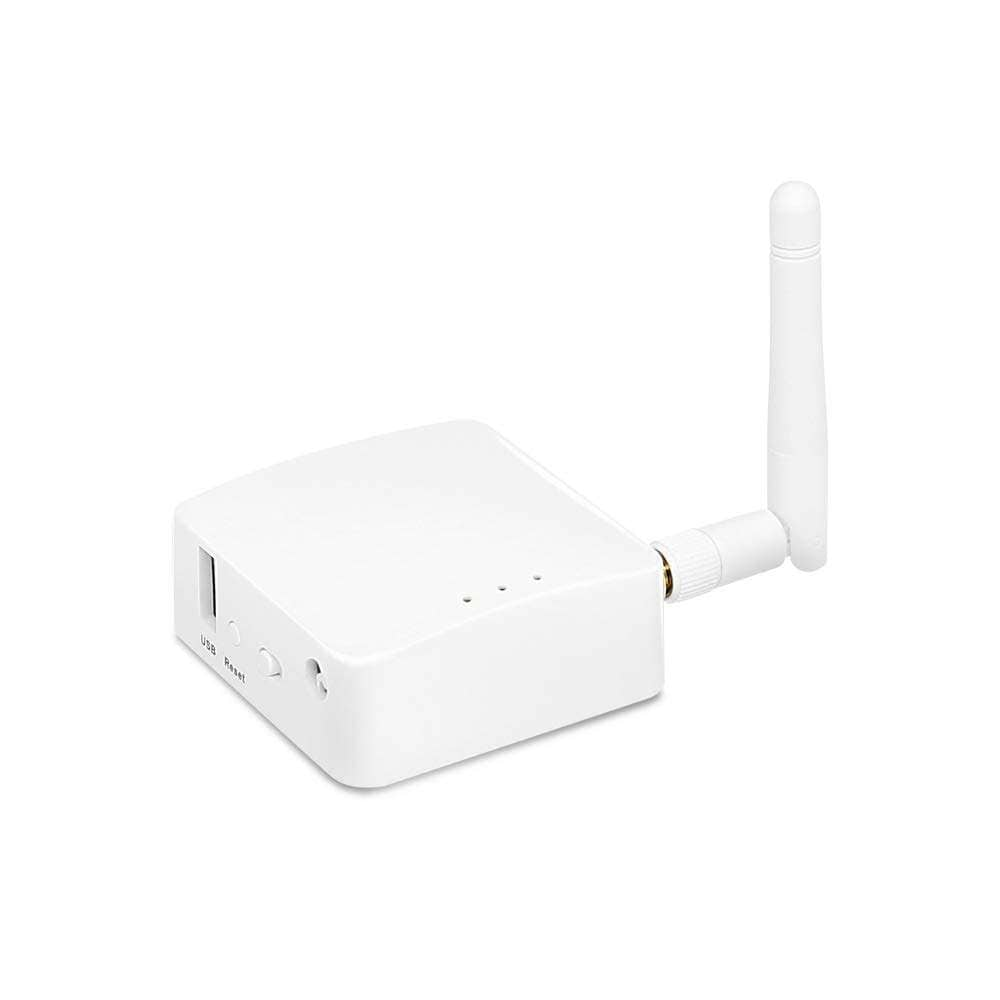
4. UTT HiPER 518 VPN
It doesn’t matter if you like to use VPN for your home network or small business, this Amazon hardware VPN will come handy to you on numerous occasions. It comes with a quick setup wizard as well to assist you.
- The hardware VPN supports real-time backup
- Inbuilt load balancing feature
- Several advanced features like native firewall, access control, IP binding, NAT, and more
- 5 VPN tunnels can be used
- Has an auto negotiation and auto MDIX property
- It has 2 10/100M WAN ports and 10/100 LAN ports
- Ethernet connectivity with 100 Mbps data transfer rate
- Warranty: 1 year
Price: $40

5. Dell Sonicwall TZ300 VPN
Another secure Amazon hardware VPN that you can try is from the house of Dell. Even though it is a high-performance router, you might need to walk an extra mile to setup its VPN compared to other products.
- The VPN hardware is optimized for Windows, Mac, and Android users
- It has an inbuilt SSL encryption.
- Comes with an anti-virus, anti-spyware, and intrusion prevention technology
- Supports IPSec and USB connectivity
Price: $554

6. Linksys Business Dual WAN VPN Router
This hardware VPN router by Linksys is majorly designed for small and medium-sized offices. This site-to-site VPN supports Ethernet connectivity and has a remarkable data transfer rate of 1000 Mbps.
- It provides 110 Mbps IPSec and 900 Mbps firewall
- There are 5 OpenVPN tunnels dedicated to iOS and Android devices
- Besides that, it has 50 site-to-site IPSec tunnels
- Inbuilt features like WAN failover and load balancing
Price: $165
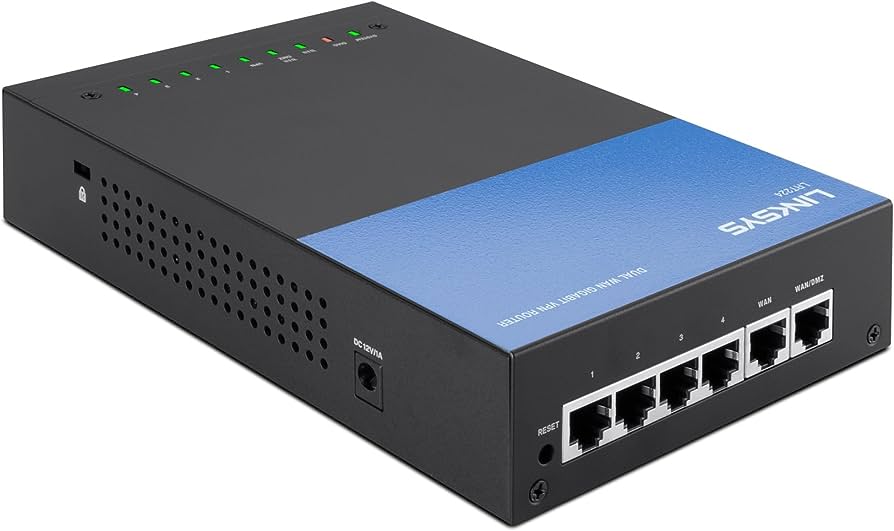
7. D-link 8-port Gigabit VPN Router
This router by D-link is an ideal pick for hardware VPN for home use and small offices. It supports Green Ethernet to optimize its power needs as well.
- VPN tunnel integration – 25 IPSec and 25 PPTP/L2TP tunnels
- It has 8 LAN (Gigabit) ports and 1 WAN (Gigabit) port
- Additionally, it has 5 SSL tunnels and 10 GRE tunnels
- Easy to configure, the VPN firewall comes with its GUI interface
- Administrations can also block websites with its dynamic web content filtering feature
- Limited lifetime warranty
Price: $130
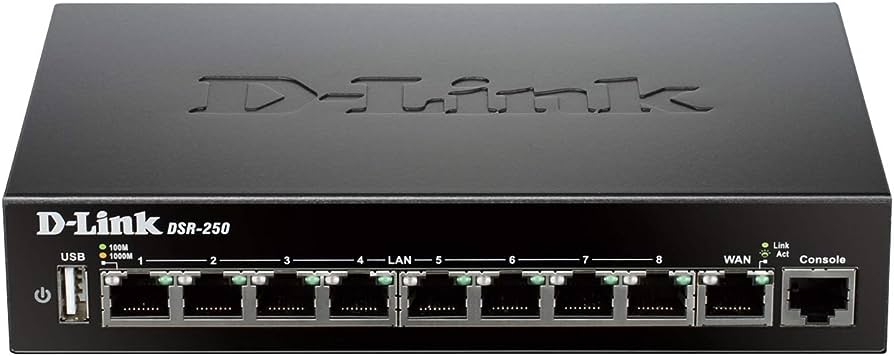
8. TP-Link SafeStream VPN Router
This Amazon hardware VPN by TP-Link is one of the most popular Gigabit VPN routers out there. It comes in numerous versions as well and can be upgraded as per your requirements for a hardware VPN for home use.
- Supports 20 IPSec and 16 PPTP VPN tunnels
- Also has 4 Gigabit LAN and 1 Gigabit WAN port for high connectivity
- Advanced encryption techniques including AES128, AES192, AES256, DES, and 3DES with MD5 and SHA1 Authentication
- Also provides Manual and IKE Key Management
- DoS defense protection (with SPI firewall)
- Warranty: 1 year
Price: $57

 EmEditor Professional (Lifetime License, non-store app)
EmEditor Professional (Lifetime License, non-store app)
Alternative: Set Up VPN on Common Hardware Devices
With any of the above VPN hardware devices, you can set up reliable VPN services in your home or office.
But many of them come with a high price, and may prove to be expensive for some individual users.
So, for a common PC, phone, router, Android TV, etc., how to set up VPN in a more affordable manner?
Many users choose NordVPN to do it for the following reasons:
- Supports 6 devices at the same time.
- VPN service can be set up on Windows, Mac, Android, iOS, Linux, and a wide range of routers.
- 24 / 7 customer service available.
- VPN service provider for large companies like CNN and BuzzFeed.
- As low as roughly 3 USD per month.
Now when you know about the various options for hardware VPN for home use and business purposes, you can easily pick a VPN hardware of your choice. We have listed different kinds of options in this post, helping you make up your mind. You can always visit their Amazon page and get more information about them. Go ahead and pick the hardware VPN of your choice and let us know about it as well.
Dr.Fone - Virtual Location
1-Click Location Changer for both iOS and Android
- Teleport from one location to another across the world from the comfort of your home.
- With just a few selections on your computer, you can make members of your circle believe you’re anywhere you want.
- Stimulate and imitate movement and set the speed and stops you take along the way.
- Compatible with both iOS and Android systems.
- Work with location-based apps, like Pokemon Go , Snapchat , Instagram , Facebook , etc.
3981454 people have downloaded it
How to Stop Google Chrome from Tracking Your Location On Samsung Galaxy F34 5G?
Do you know your web browser is continually sharing your actual location online? You might not have noticed, but the number of websites using your location has increased. As you are well aware of the dangers of the internet, it doesn’t make sense to turn your Chrome into a beacon for ill-intentioned people. Luckily, it is possible to fake a location on Chrome with the right tool.
Are you wondering how to fake the browser location or which tool to use? You can get all your answers by reading this article till the end.
 dotConnect for Oracle is an ADO.NET data provider for Oracle with Entity Framework Support.
dotConnect for Oracle is an ADO.NET data provider for Oracle with Entity Framework Support.

Part 1: How Does Chrome Know Your Location?
Before discussing Google Chrome’s fake location, it is important to know how Chrome detects your physical location. Google Chrome uses many ways to pinpoint your exact location, like your IP address, GPS, Wi-Fi, Bluetooth, and Cell Tower data. Every internet connection has an IP address bound to a location that enables Chrome to identify your location.
Similarly, GPS location can easily be tracked if your phone device has it enabled. All the Wi-Fi and Bluetooth connections around you also have location information embedded in them. They can help Chrome track you as long as your device can detect them. If you use cell data, Google Chrome can also track you through cell towers.
Part 2: How to Hide Location Services in Chrome?
If you are worried about Google Chrome detecting your physical location and sharing it with websites and apps, you can hide it easily. The process of hiding your location on Google Chrome is simple, even if you are using multiple devices. Below is the step-by-step process of hiding location services in Google Chrome on computer, Android, and iOS devices.
Method 1: For Laptop and Desktop PCs
Step 1: Launch Google Chrome on your computer and click the “Three Dots” icon to open the Google Chrome Settings. Here, tap “Privacy and Security” from the left sidebar and select “Site Settings.”

Step 2: Navigate to “Permissions” and click on “Location.” To hide the location on Google Chrome, select the “Don’t allow sites to see your location” option.

Method 2: For iPhone or iPad
Step 1: Navigate to “Settings” on your iPhone and open it. Scroll down until you find the “Chrome” app option and select it.

Step 2: Press “Location” on the next screen to open the location options for Google Chrome. Here, choose “Never” to stop Google Chrome from detecting your location.

Method 3: For Android
Step 1: Open Google Chrome on your Samsung Galaxy F34 5G, press the “Three-Dots” icon, and tap “Settings” from the options.

Step 2: In Chrome Settings, press “Site Settings.” Now select “Location” and hide your location by toggling off the “Location” option.

One way to protect your privacy and stop websites from tracking your location is to turn off the location, but it has many disadvantages. If you have turned off your location, you can’t use any location base service like food delivery, e-shopping, ride-sharing, etc. That’s why it is better to use a fake location on your browser. Below we have explained four methods for Chrome fake location.
Method 1. Best Tool to Fake Chrome Location On iOS and Android Phones
The easiest and quickest way to fake your location on Google Chrome is to use Dr.Fone - Virtual Location . Since smartphones contain a wide range of apps that require location access, it provides a stable way to fake Chrome locations on Android and iOS phones. No website or app will be able to detect that you are using a fake location when using Dr.Fone - Virtual Location for faking GPS location.
Key Features
- Dr.Fone - Virtual Location can be used for any social media app like Facebook, Twitter, or Instagram with a fake location.
- With the help of this tool, you can also spoof real-time tracking apps like Life360 to protect your privacy.
- If you are an iPhone user, you don’t have to jailbreak your iPhone to spoof your device’s location.
How to Fake Chrome Location On iOS/Android Phones via Dr.Fone - Virtual Location
Faking your Chrome location with Dr.Fone - Virtual Location is very straightforward. You only need the Dr.Fone mobile toolkit and a USB cable to connect your Samsung Galaxy F34 5G. Follow these steps to spoof Chrome location on Android and iOS phones:
Step 1: Connect Your Android/iOS Device to Your Computer
Connect your Android or iOS phone to your computer using a USB cable. Launch the Dr.Fone robust toolkit on your computer and select “Virtual Location.”

Step 2: Activate the Teleport Mode
Press “Get Started” on the next page to open the map window. First, select your actual location by pressing the “Center On” icon from the right sidebar. Afterward, click on the “Teleport” icon from the top right corner to activate the Teleport Mode.

Step 3: Add the Desired Fake Location
Once the Teleport Mode is activated, add your desired location and press “Go.” Your desired location will open on the map. Select it, and a pop-up window will appear where you need to press “Move Here.” With that, your Android or iPhone’s Chrome location has been changed.

Method 2. Manually Change Your Location Using Google Chrome DevTools
It is also possible to fake browser location on Chrome using the Google Chrome Developer Tools. It is a built-in feature of Chrome and can be used to manually change or turn off your browser’s location. Follow these steps for changing location on Chrome with DevTools:
Step 1: After opening Google Chrome, click the three-dots icon from the top right corner. It will open the Chrome menu where you need to select “Developer Tools” after clicking “More Tools.”

Step 2: A window will open on the right side with all the developing tools you can use in Chrome. Click on the three-dots icon located near “Console” in the bottom left corner of the window. Choose “Sensors” from the pop-up menu.

Step 3: Access the newly selected “Sensor” option, and here you can change the browser’s location by either selecting a Google’s pre-set location or adding your desired location manually. Once the location is selected or added, your browser’s location will change.

Limitations
- The interface of the Google Chrome DevTools can be very confusing and overwhelming for non-technical users.
- Apart from pre-added locations, it can be hard to add a specific location as your fake location.
Method 3. Fake Your Location Using Chrome Extension
Many fake location Chrome extensions are available on Google Chrome which can be used to alter your location on Chrome. You can find these extensions on Google Chrome Web Store and add them directly to your browser. Below we have explained the steps for using such an extension “Location Guard “ to fake your location on Google Chrome:
Step 1: Open the “Location Guard” on Chrome Web Store and click “Add to Chrome” to add it to your browser. Once the “Location Guard” extension is added, open it and press “Options.”

Step 2: In the options, you can choose different options like Privacy Levels, Protection Area, and Time for Location Cache. It is recommended you choose a higher level for more protection.

Step 3: You can also use the “Fixed Location” feature to set up a fake location as a permanent location for your browser. The fixed location can be added by using the market or clicking on the desired place on the map.

Limitations
- Location Guard doesn’t protect your IP address. It means some websites can still detect your real location using the IP address.
- The app is not updated for quite a while, that’s why the map of the fixed location feature is quite restricted.
Method 4. Spoof Your IP Using a VPN Server
Another way you can fool websites and your browser by displaying a fake location online is to use a VPN server. VPNs fake your IP address to fool websites and apps into detecting your location. NordVPN is a VPN that can be used to spoof your IP by following these steps:
Step 1: Download and install NordVPN on your computer or phone and log in using your account. If you don’t have a NordVPN account, you must create one first.
Step 2: If you want to just change the location of your device, you can select “Quick Connect.” Using it will enable the program to automatically find the most suited fake location for you.

Step 3: You can also choose the desired location as your fake Chrome location in NordVPN. To do that, scroll down the list of countries and locations and choose your desired locations to connect to.
Limitations
- NordVPN can only spoof your IP address and will not work for geo-restricted applications.
- Using a VPN usually affects your internet speed and can make browsing slower and more difficult.
Part 4: FAQs
1.What is Geolocation?
Geolocation is a term used for the process of pinpointing the location of a device connected to the internet. The location can be determined using methods like IP address, GPS, and mobile tower data. Apps and websites commonly use it to provide location-based services.
2.What is the HTML5 Geolocation API?
The HTML5 Geolocation API is a browser API used to determine a user’s geographical location. Developers use it to build location-aware websites and apps that use users’ locations as the basis for providing their services. It can detect location through GPS, Wi-Fi, Bluetooth, IP addresses, etc.
3.Why should you hide or spoof your Location?
Hiding or spoofing your location protects your privacy and stop application and websites from tracking you. It also allows you to access geo-restricted apps and play location-based games. You can also fake your location to get the latest updates of your favorite apps.
Conclusion
The fact that Google Chrome in your devices can track your location with an accuracy of up to 20 meters is very unsettling for users. Even when you try to be careful in granting location permissions to apps and websites, many can still bypass this by adding location access requirements in terms and conditions.
That’s why having a tool like Dr.Fone - Virtual Location to fake GPS online is essential nowadays. It can ensure your privacy and helps in protecting you from the dangers of the internet.
- Title: Prevent Cross-Site Tracking on Samsung Galaxy F34 5G and Browser | Dr.fone
- Author: Ava
- Created at : 2024-08-01 20:48:29
- Updated at : 2024-08-02 20:48:29
- Link: https://fake-location.techidaily.com/prevent-cross-site-tracking-on-samsung-galaxy-f34-5g-and-browser-drfone-by-drfone-virtual-android/
- License: This work is licensed under CC BY-NC-SA 4.0.


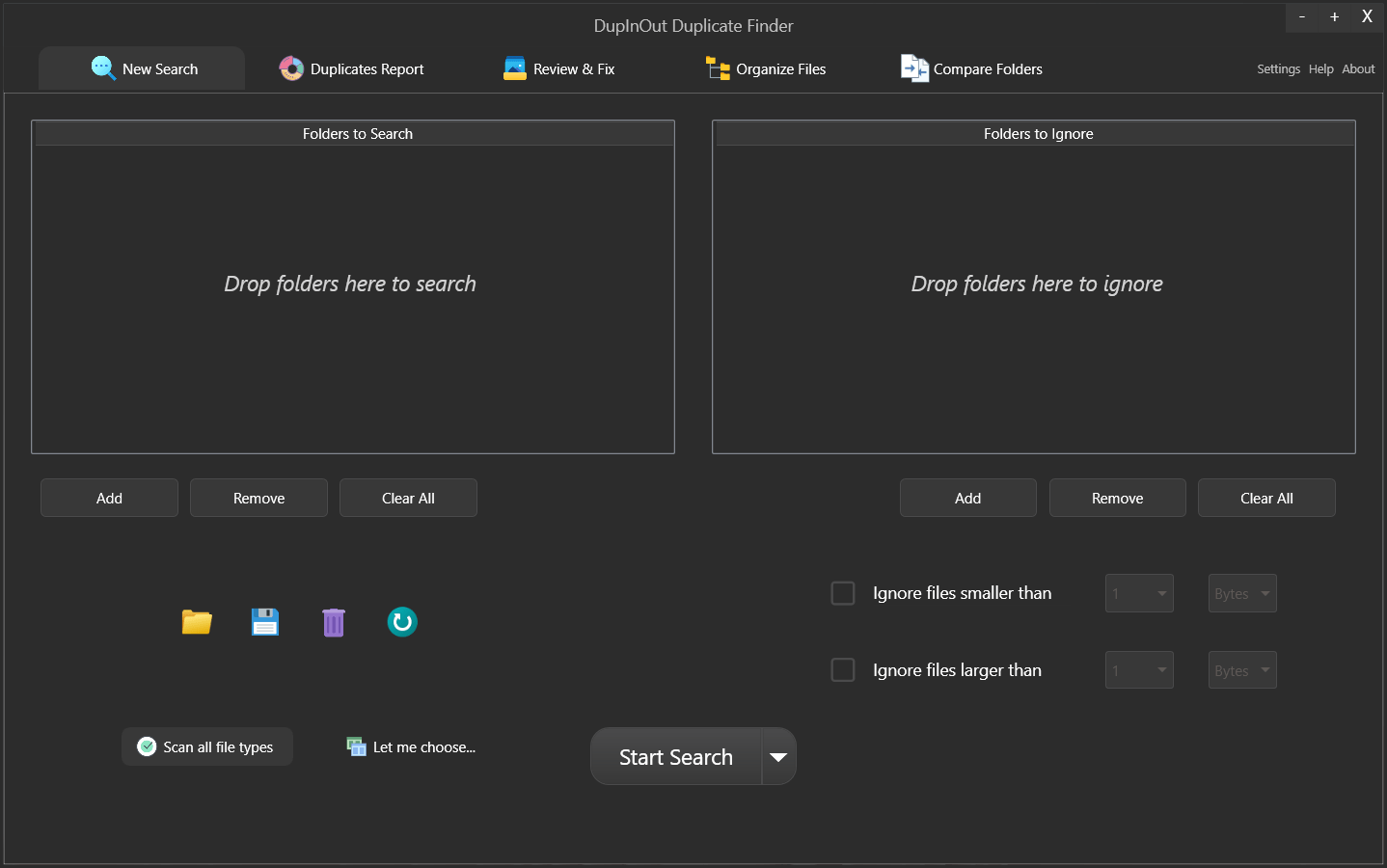
 Epubor Audible Converter for Mac: Download and convert Audible AAXC/AA/AAX to MP3 with 100% original quality preserved.
Epubor Audible Converter for Mac: Download and convert Audible AAXC/AA/AAX to MP3 with 100% original quality preserved. CalendarBudget - Monthly subscription membership to CalendarBudget via web browser or mobile app. Support included.
CalendarBudget - Monthly subscription membership to CalendarBudget via web browser or mobile app. Support included. 


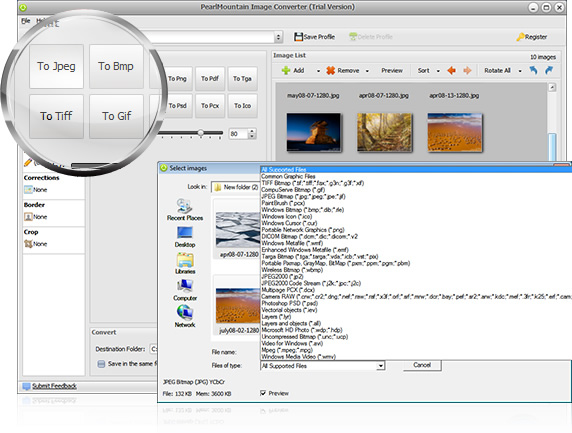 PearlMountain Image Converter
PearlMountain Image Converter Jet Profiler for MySQL, Enterprise Version: Jet Profiler for MySQL is real-time query performance and diagnostics tool for the MySQL database server. Its detailed query information, graphical interface and ease of use makes this a great tool for finding performance bottlenecks in your MySQL databases.
Jet Profiler for MySQL, Enterprise Version: Jet Profiler for MySQL is real-time query performance and diagnostics tool for the MySQL database server. Its detailed query information, graphical interface and ease of use makes this a great tool for finding performance bottlenecks in your MySQL databases. 

 PCDJ DEX 3 for Windows & MAC is the total entertainment DJ software solution, offering audio, video, and karaoke mixing ability. Automatic beat-sync, smart looping, 4 decks, DJ MIDI controller support, Karaoke Streaming and much more.
PCDJ DEX 3 for Windows & MAC is the total entertainment DJ software solution, offering audio, video, and karaoke mixing ability. Automatic beat-sync, smart looping, 4 decks, DJ MIDI controller support, Karaoke Streaming and much more.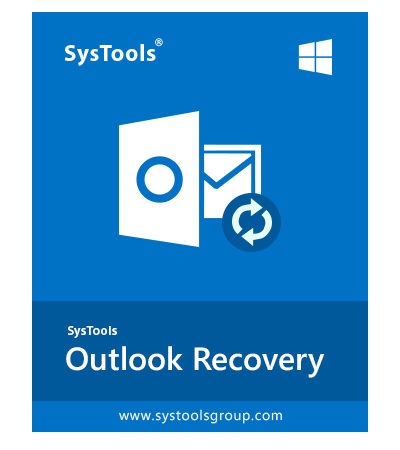
 CollageIt Pro
CollageIt Pro
